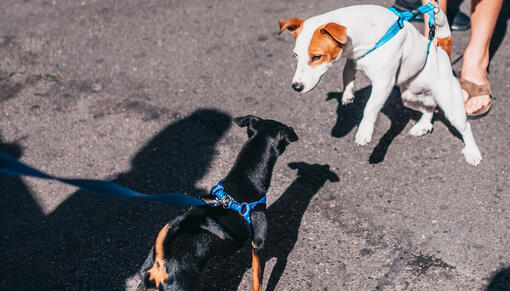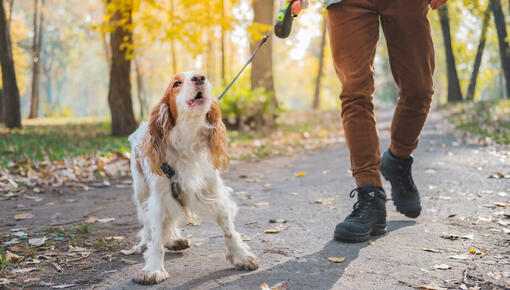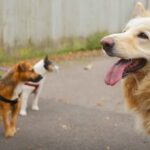If you often witness your dog losing their cool when seeing other pooches, it’s time to make some changes. In this article, we’re going to go over some quick tips and tricks on how to train your dog to ignore other dogs so that you can both enjoy your walks together.
Having a social butterfly as a furry companion can be great and all but what happens if your pup is overly social, perhaps going off the rails with excitement whenever they see another pooch? Or if they are reactive? Those occurrences can definitely put a dampener on a nice walk in the park, not to mention your dog’s safety. To learn how to train your dog to ignore other dogs it is also key to understand the reasons motivating their behaviour.
With dog ownership numbers increasing, your dog is bound to meet other dogs when out and about so it is more important than ever to teach them how to navigate these social encounters appropriately – and this starts right back at puppyhood.
Socialising your puppy

While puppies love to play with other puppies or friendly adult dogs, socialisation is about far more than this. The key part of socialisation isn’t that your puppy learns that all other dogs are for playing with, it is that they learn to pay attention to you when there are other dogs around.
The main part of a good socialisation class is that while the puppies may get a chance to learn how to play with other dogs in small well-matched groups, the majority of the class should be about relaxing and focusing on you while around others – as this is what you are going to want when you are out and about.
It is a mistake to think that ‘normal’ dogs are very social and that a well-socialised dog should want to play and interact with all other socialised dogs. Adult dogs, like adult humans, are ‘selectively social’ – so they have a small group of friends who they enjoy spending time with and playing with but aren’t that interested in others outside of that group and indeed might not like being pestered by them and respond accordingly. This doesn’t make them ‘antisocial’ – in fact it makes them perfectly normal.
Choose a socialisation class that gives you the chance to practice the skills above, and your dog will be far less likely to be reactive, over-excited, or just crazy when they see other dogs out on a walk. Prevention is far better than cure – and most reactive dogs are fearful (and most overly social dogs are just a bit rude!).
Five reasons dogs bark at other dogs
There are several triggers that can cause your dog to start barking or get anxious at the mere sight of other dogs. We’ve listed a few here.
1. Over-excitement or poor self-control
It might be that your pooch is overly excited just because they want to be friendly and play. They can bark because they’re really excited (especially if they know the other dog) or they can bark because they are on a lead and so are getting really frustrated that they can’t charge over and meet their potential new playmate. This frustration can escalate however…
2. Fear or anxiety
Dogs who haven’t been adequately socialised or who have had bad or traumatic experiences with other dogs in the past can become anxious or fearful. Fear in dogs is a powerful emotion – and when you couple that with an inability to escape (as they are being held on a lead) it can lead to intense barking and reactive behaviour.
3. Frustration
Sometimes, excessive barking at the sight of another dog can be caused by their frustration of not being able to get close to them. In these cases, the dog can be quite happy meeting other dogs off-lead but on-lead they become highly reactive.
4. Inability to show natural body language
Dogs communicate with each other using body language. If you watch dogs greeting each other, they never approach head on but always from about 45 degrees, they will circle round each other, sometimes advance and sometimes back up (or even go off and pretend to be smelling something interesting etc), will sniff and investigate (this is where bottom sniffing comes in – as it is the best place to get all the scents needed for a dog to find out about the other dog while being as far away from the teeth as possible) and only then decide if they are going to interact. When we have our dogs on a lead, they can’t do any of those things and so it’s easy for them to ‘miscommunicate’ which can cause issues.
5. Aggression
Frustration, fear, and misunderstood communications can lead to aggression – and for many dogs, this then becomes the default behaviour when they see other dogs. Behaviours that get practised get repeated – plus aggression is generally a dog’s way of ‘making bad stuff stop’ or ‘making bad stuff go away’.
How to train your dog to ignore other dogs in 6 easy steps

The best way to teach your dog to ignore other dogs is by redirecting their attention on to you instead of focusing on the other dog. Here are some steps you can follow to achieve this.
1. Get their attention by calling their name
Do this randomly throughout the day. Call their name, wait for them to look at you, and reward them with a high value treat when they do. Do this no matter what they are doing or where they are (as long as they are not sleeping) so you can get their attention in a variety of places and situations.
2. Avoid places with many dogs
Start training your dog in a quiet place indoors where it’s just the two of you. Once you can do this at home, you can progress to the garden where there are more distractions from sights, sounds, and smells. Once you’ve mastered that, you can start going out and about – but stick to quiet places where you can avoid other dogs until you and your dog are experts at this.
3. Distract them when meeting other dogs
Once you know how to get your dog to ignore other dogs and they start responding to you calling their name, you can start using this technique in the presence of other dogs. Start off a long distance from them – beyond the point where your dog would usually react – and keep their attention until the dog has gone. Slowly build this up to being able to do it at closer proximity. Always use high value treats (your dog’s favourites) to reward them for paying attention to you and not the other dog. If your dog is toy motivated and it’s possible and safe to have a game after the dog has passed, that can work really well too (especially if the excitement at seeing another dog is because they want to play).
4. Practice is key
Remember that patience is very important when training any dog and you shouldn’t expect instant results. It is about being consistent and training each step very slowly and practising a lot. Practice can take some time and results can vary depending on your dog’s personality and breed so be prepared to allocate sufficient time and effort for training sessions. It is also about avoiding situations where you know your dog will be reactive – and that might be avoiding other dogs by turning round and going in the opposite direction rather than having an encounter that will sabotage all your good training.
5. Give play opportunities
Make sure your dog still gets a chance to play and interact with their chosen doggie friends. Dogs are social and do enjoy having some ‘dog time’ – and you don’t want to create frustration by preventing all dog-to-dog interactions so set up play dates or dog walks with a chance for off-lead play regularly with your dog’s best friends.
6. Use a long leash and avoid pulling on it
While you are training, you can use a comfortable harness with a long leash. This will allow your dog to have more freedom and practise your distraction training safely at a longer distance – and if you need to, gently guide your dog back to you. Do be careful with dog interactions however that the dogs don’t get entangled.
Whether triggered by fear, anxiety, or excitement, a dog that always barks or lunges at other dogs can make your daily walks together considerably less enjoyable. Learning how to train your dog to ignore other dogs can put a stop to this kind of behaviour and help you strengthen your bond with your furry best friend.
If however, you are concerned that your dog is becoming aggressive, could injure another dog or person, or if you hit a block with your training, contact an accredited, experienced dog behaviourist who can help you.









